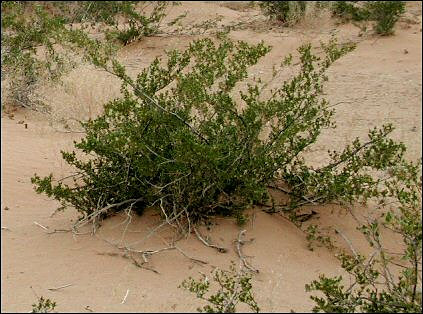
In Nature, prey and predator engage in constant battle: prey evolve ways to avoid being eaten while predators evolve ways around those defenses. Such is the case with Creosotebush and the Creosote Grasshopper, Bootettix punctatus, which feeds exclusively on that plant.
Creosotebush leaves are protected by a resinous coating, making them indigestible to most browsers. But over time, this obstacle was surmounted as the Creosote Grasshopper's foregut developed the ability to add more oxygen into its digestive process, partially deactivating the resin and increasing digestibility. The plant responded by protecting its vital buds and young leaves with higher resin levels compared to mature leaves. Curiously, though, the resin content in all leaves is lower in early evening than at any other time, becoming the plant's Achilles heel in this confrontation. For the grasshopper feeds mostly in the early evening, when resin levels are lowest.
What will be the next strategy? That is uncertain, but the interplay
between these two species, and others, will continue as part of the never ending
struggle between those who produce and those who consume.
![]()
Contributor: Scott M. Cutler, Centennial Museum, University of Texas at El Paso.
Desert Diary is a joint production of the Centennial Museum and KTEP National Public Radio at the University of Texas at El Paso.

Creosotebush (Larrea tridentata), dinner for the Creosote Grasshopper (Bootettix punctatus). Photograph by A.H. Harris.
Nabhan, G. 1985. Gathering the Desert. University of Arizona Press, Tucson. 209 pp. (A popular book with a mention of this type of interaction between Larrea sp. and another grasshopper, Astroma sp.)
Schultz, J.C., D. Otte, F. Enders. 1977. Larrea as a habitat component for desert arthropods. Pp. 176-208, in T. J. Mabry, J. H. Hunziker, and D. R. Difeo, Jr.(eds.). Creosote Bush—Biology and Chemistry of Larrea in New World Deserts. Dowden, Hutchinson and Ross, Stroudsburg, Pa. 284 pp.